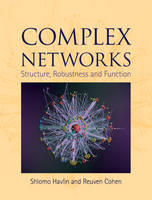
Complex Networks
Cambridge University Press (Verlag)
978-0-521-84156-6 (ISBN)
Examining important results and analytical techniques, this graduate-level textbook is a step-by-step presentation of the structure and function of complex networks. Using a range of examples, from the stability of the internet to efficient methods of immunizing populations, and from epidemic spreading to how one might efficiently search for individuals, this textbook explains the theoretical methods that can be used, and the experimental and analytical results obtained in the study and research of complex networks. Giving detailed derivations of many results in complex networks theory, this is an ideal text to be used by graduate students entering the field. End-of-chapter review questions help students monitor their own understanding of the materials presented.
Shlomo Havlin is a Professor in the Department of Physics at Bar-Ilan University, Israel. He is an editor for several physics journals, has published over 600 articles in international journals, co-authored and co-edited 11 books, and won numerous awards for his work including the Weizmann Prize (2009) and the APS Lilienfeld Prize (2010). Reuven Cohen is a Senior Lecturer in the Department of Mathematics at Bar-Ilan University, Israel. He has written many papers in the fields of complex networks, robot swarms, algorithms and communication networks, and has won several national and international prizes for his work.
1. Introduction; Part I. Random Network Models: 2. The Erdos–Renyi models; 3. Observations in real-world networks; 4. Models for complex networks; 5. Growing network models; Part II. Structure and Robustness of Complex Networks: 6. Distances in scale-free networks: the ultra small world; 7. Self-similarity in complex networks; 8. Distances in geographically embedded networks; 9. The network's structure - the generating function method; 10. Percolation on complex networks; 11. Structure of random directed networks - the bow tie; 12. Introducing weights: bandwidth allocation and multimedia broadcasting; Part III. Network Function: Dynamics and Applications: 13. Optimization of the network structure; 14. Epidemiological models; 15. Immunization; 16. Thermodynamic models on networks; 17. Spectral properties, transport, diffusion and dynamics; 18. Searching in networks; 19. Biological networks and network motifs; Part Appendix A. Probability theoretical methods; Appendix B. Asymptotics and orders of magnitude; Appendix C. Algorithms for network simulation and investigation; References; Index.
| Erscheint lt. Verlag | 8.7.2010 |
|---|---|
| Zusatzinfo | Worked examples or Exercises; 45 Halftones, black and white; 11 Line drawings, black and white |
| Verlagsort | Cambridge |
| Sprache | englisch |
| Maße | 193 x 253 mm |
| Gewicht | 700 g |
| Themenwelt | Naturwissenschaften ► Chemie ► Physikalische Chemie |
| Naturwissenschaften ► Physik / Astronomie ► Thermodynamik | |
| ISBN-10 | 0-521-84156-9 / 0521841569 |
| ISBN-13 | 978-0-521-84156-6 / 9780521841566 |
| Zustand | Neuware |
| Haben Sie eine Frage zum Produkt? |
aus dem Bereich


